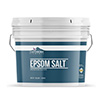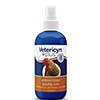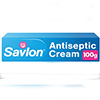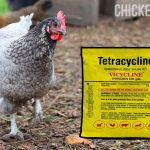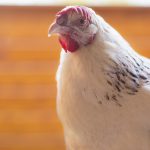Bumblefoot In Chickens: Causes And Treatment (+ Vet Advice)
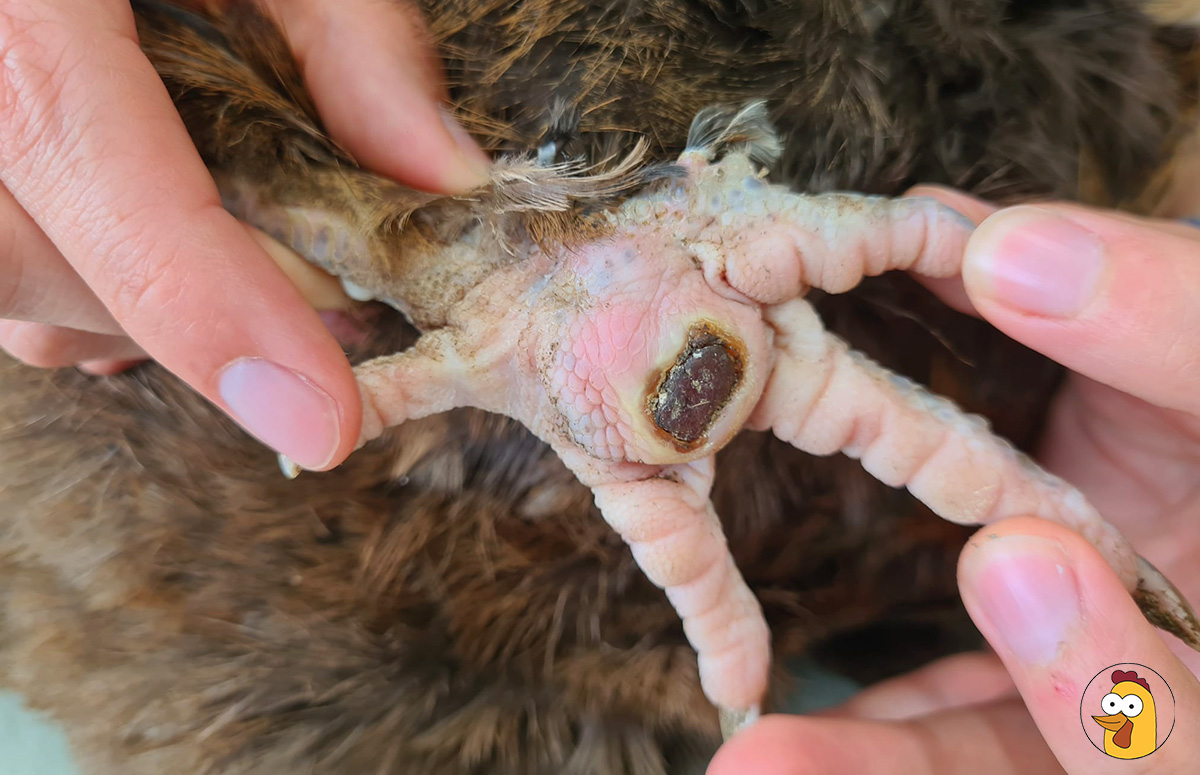

Chicken Fans is reader-supported. When you buy through our links, we may earn a commission. Learn more about our privacy policy and disclaimer.
Bumblefoot in chickens is a common foot condition that often goes unnoticed. Although seemingly harmless, bumblefoot has the potential to disrupt egg production and compromise your chickens’ well-being.
Let’s delve into the causes, symptoms, and treatment of bumblefoot.
WARNING: This article includes photos of bumblefoot and the removal of bumblefoot!
What is Bumblefoot in Chickens?
Bumblefoot, also known as pododermatitis or foot pad dermatitis, is a staph infection that affects chickens’ feet. It creates a hard core on the footpad resembling a bumble or kernel. It can develop on one or both feet and affects chickens of all ages and sexes, as well as ducks.
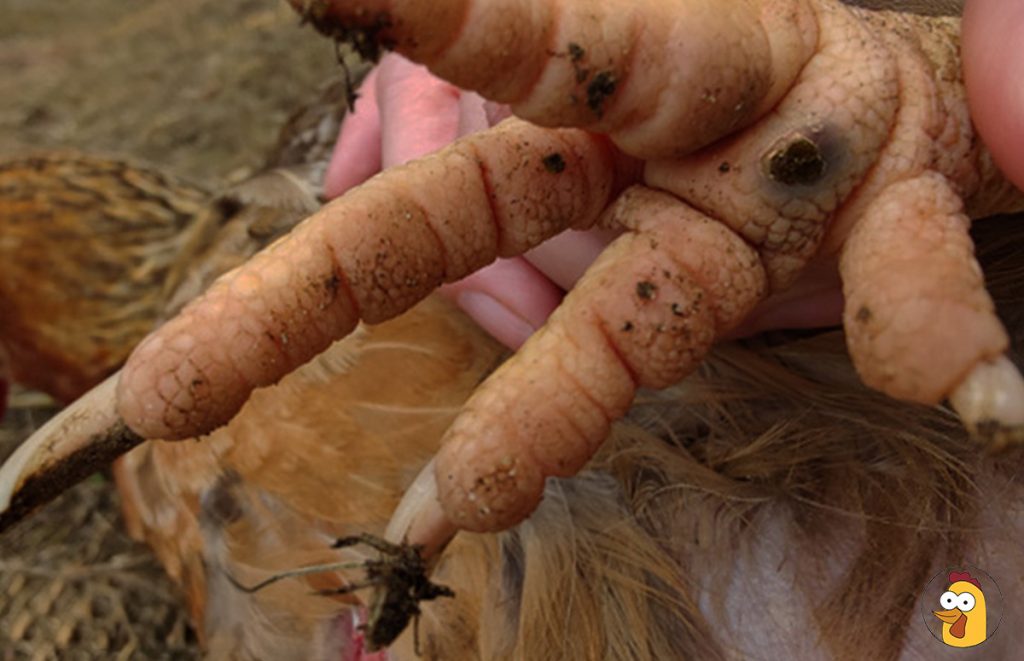
Is Bumblefoot Dangerous?
Yes, if left untreated, bumblefoot is dangerous. First, it spreads locally, affecting bones and tendons. Then, in severe cases, it enters the chicken’s bloodstream, causing systemic infection (septicemia).
First Aid for Bumblefoot in Chickens
When caught early, milder cases of bumblefoot in chickens can be managed at home. Here is a breakdown of the necessary items and the steps to take.
This listicle and treatment method is created by a veterinarian with experience treating bumblefoot in chickens:
List Of Must-Have Items
- Bucket with lukewarm water
- Clean cloth or paper towels
- Sterile gauze
- Vet wrap
- Epsom salt or chamomile tea
- A clean, sterile scalpel
- Antibacterial spray
- Antimicrobial cream
This is how it looks when the infection is removed properly by a licensed veterinarian.
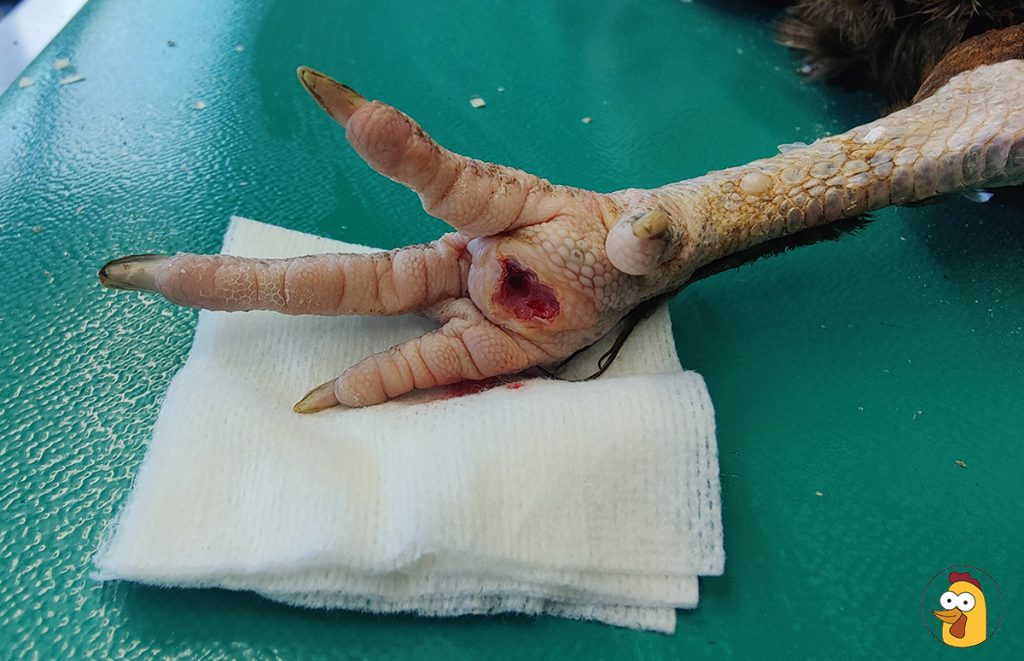
Treatment and First Aid of Bumblefoot
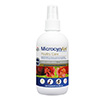
MicrocynAH Poultry Wound & Skin Care
To clean wounds, lacerations, skin rashes
Manna Pro
CHECK PRICE

CHECK PRICE
- Rinse the affected foot and scrub gently to remove dried poop and debris.
- Soak the foot in lukewarm water mixed with Epsom salts or chamomile tea for at least 10-15 minutes.
- Try lifting the scab or use the scalpel to remove it.
- Apply pressure with a clean cloth or paper towel to stop the bleeding with cotton balls or pads.
- Spray the area with an antibacterial spray such as Vetericyn.
- Apply antimicrobial cream to the wound and cover the wound with a sterile gauze.
- Securely bandage the foot with a piece of vet wrap. Optional: put a protective shoe on the chicken’s foot for cushioning.
Once the procedure is performed, spray the wound, apply antimicrobial cream, and re-wrap the affected foot daily. If the wrap gets dirty or wet, change it immediately.
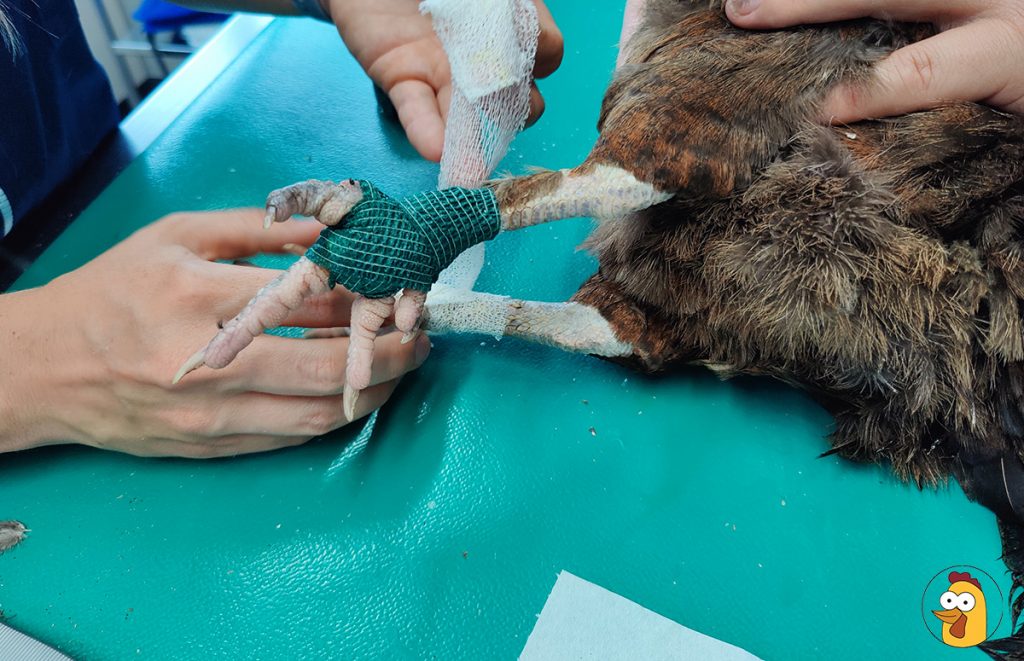
If other flock members bully the chicken with bumblefoot or they seem too interested in the bandage (and peck it a lot), it is best to isolate the chick until the treatment is completed.
Finally, contact a veterinarian if the condition is too advanced for safe at-home removal. The vet will surgically remove the infected area and prescribe treatment. This may include antibiotics.
After just two weeks, the wound should almost be healed, allowing you to reintroduce the chicken to the rest of the flock.
Keep the foot wrapped until the wound is completely healed.
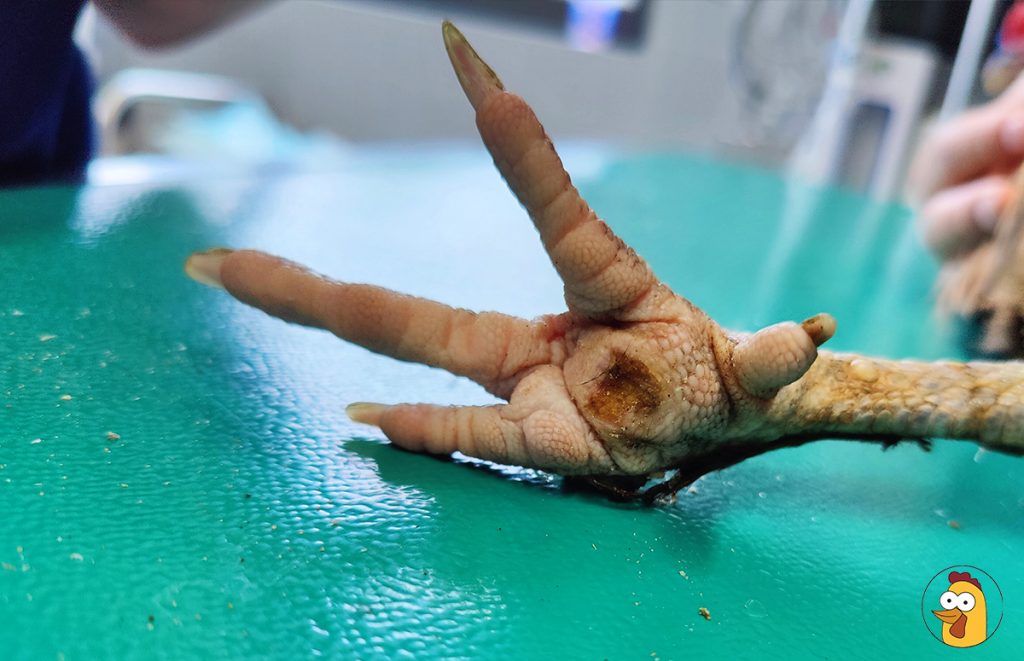
Causes and Risk Factors of Bumblefoot in Chickens
Bumblefoot is caused by the bacterium Staphylococcus aureus. It all starts when the chicken sustains an injury on the foot. The low-oxygen environment within the wound is perfect for S. aureus to grow and thrive.
As for what causes the injury on the chicken’s foot, there are several risk factors:
- Poor Hygiene: Splinters, nails, or other sharp objects can cause injuries, and droppings increase the risk of infections.
- Hard Walking Surfaces: Concrete and wire floorings are abrasive, as well as rocky terrains in free-range chickens.
- Inadequate Litter: Some litter types are more likely to promote infection as they retain moisture.
- Vitamin A Deficiency: Lack of vitamin A makes the skin flaky, weak, and more prone to injuries.
- Large Body Size & Obesity: The extra pressure weakens the foot’s skin, making it more likely to get injured.
- Overgrown Nails: Unless trimmed, the nails curl and cause injuries which can easily get infected with staph bacteria.
- Early Perching: Young chicks have weak feet and skin that cannot withstand pressure and damage caused by jumping from perches.
- Bullying Behavior: Frequently bullied chickens run a lot, thus putting too much exertion on the feet.
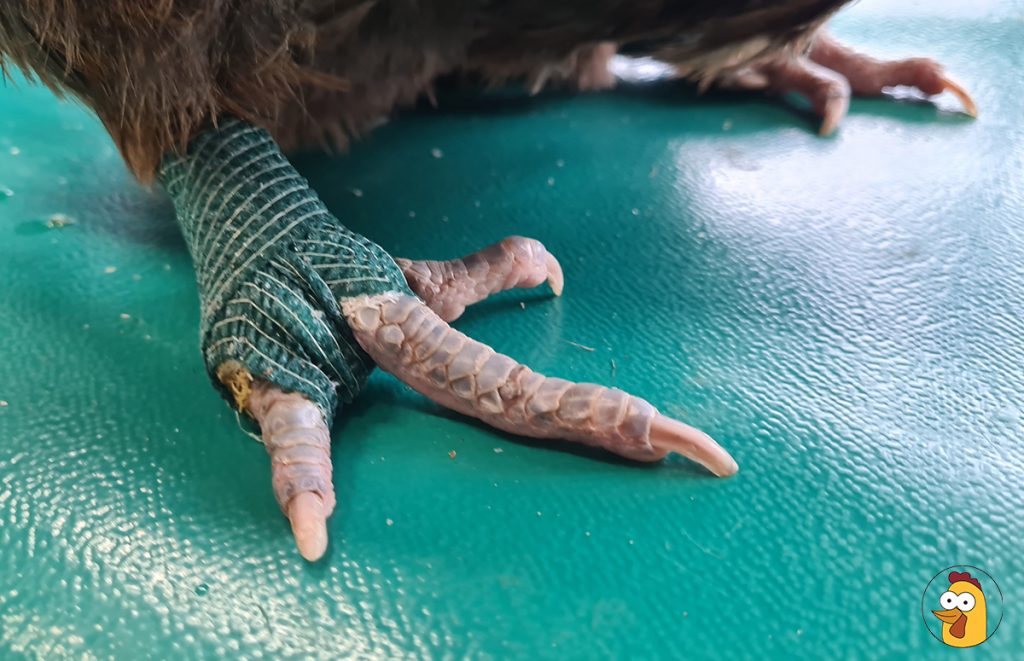
Stages of Bumblefoot in Chickens
The three telltale signs of bumblefoot in chickens are redness, swelling, and a black or brown scab on the foot. Over time, the presence of the kernel on the chicken’s foot causes pain, resulting in lameness.
The exact look of the lesion (kernel) depends on the bumblefoot stage. There are five different stages or grades of bumblefoot:
- Grade 1: Small and shiny pink area on the chicken’s foot surrounded by some level of skin peeling but free from infection signs.
- Grade 2: Smooth, shiny, and slightly swelled area with mild infection signs surrounding the lesion.
- Grade 3: The infected lesion (abscess) pops and drains fluids, leaving an ulcer (defect in the skin) surrounded by a callus (hardened tissue).
- Grade 4: Deep infection manifesting with a necrotic plug in the middle of the ulcer, causing pain and lameness.
- Grade 5: Severe swelling and infection resulting in severe lameness or complete loss of foot function.
In the very early stages, bumblefoot is not visible to the naked eye and can only be diagnosed using thermography. However, this method is not readily available to backyard chicken keepers.
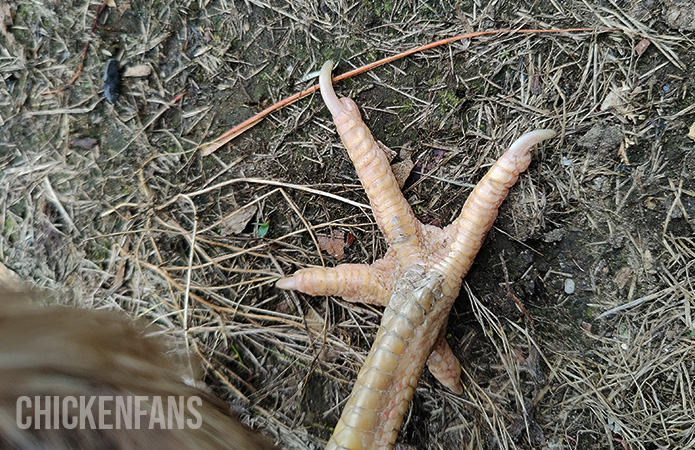
Prevention of Bumblefoot in Chickens
There are several things you can do to decrease the risk of bumblefoot in your flock. Here is an overview of the best prevention options.
Clean Environment
When it comes to maintaining a clean environment, there are two main factors – first, keeping the floor as dry as possible, and second, removing injury-causing objects, such as splinters, wires, and nails.
To keep the floor wet, install proper drainage in the coop, choose the right litter, and remove droppings regularly.
Proper Roost Height
Ideally, the roosts should be placed no more than between 2 and 3 feet from the ground. That way, heavier chickens will not put too much strain on their feet when using them.
If the roosts are high, consider installing ramps or ladders. They will allow easy access and protect the chickens’ feet.
Soft Litter In The Coop & Run
Straw and pine chips are practical but also abrasive. Therefore, it is advisable that you switch to a softer and more comfortable litter, such as sand.
Sand promotes a drier floor by helping liquids drain from the surface and coating & dissecting droppings. Plus, compared to other litter options, it is less supportive of bacterial growth.
Frequent Foot Inspections
Being vigilant and monitoring the flock carefully and regularly is vital. If possible, check your chickens’ feet at least monthly, but preferably weekly.
The good news is bumblefoot is fairly easy to recognize, even if you are not an experienced backyard chicken keeper.
Feet Care & Hydration
Keeping the chicken’s feet nourished and well-hydrated is a good idea. This is best achieved with a dog paw balm. Dog paw balm is perfectly safe for birds despite being formulated for canines.
However, if you do not have one on hand, feel free to use regular coconut oil. Whether you use paw balm or oil, ensure to spread it solely on the non-feathered parts of the legs/feet.
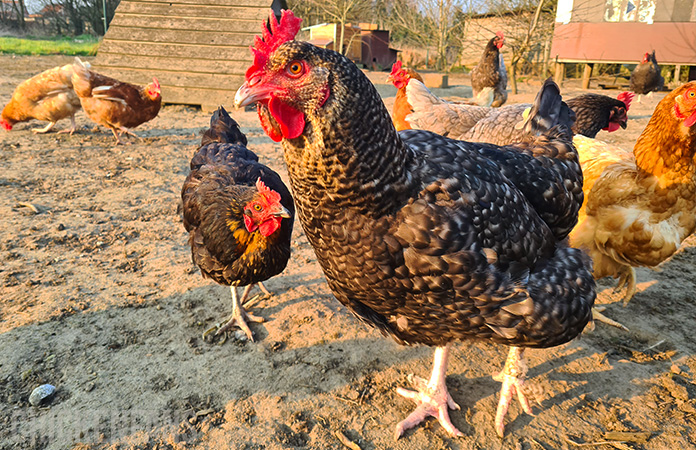
Regular Nail Trimming
To prevent curling and ingrown nails, practice regular trimming. Use pet or human clippers based on what is more practical for you. Soak the chicken’s feet in warm water if the nails are too hard before trimming.
Do not worry if you cut the nails too short and see some blood – dip the toe in flour or cornstarch to stop the bleeding.
No Overfeeding
A healthy body weight reduces the risk of bumblefoot. To avoid weight gain and obesity, provide adequate amounts of nutritionally rich and balanced food. Never overfeed your chicken. Some breeds are more prone to obesity, like Cochin chickens or other heavy breeds.
Also, limit the treats, snacks, and table scraps consumption. Ideally, these foods should not account for more than 5 to 10% of the chicken’s daily caloric intake.
Vitamin A Supplements
You can use commercially available vitamin A supplements to ensure proper intake. Alternatively, add vitamin A-rich foods to the chickens’ diet if you prefer a more natural approach.
Such foods include carrots, sweet potatoes, pumpkin, squash, and leafy greens (kale, broccoli, spinach). In addition to vitamin A, they are rich in antioxidants and will boost the flock’s immunity.
Fermented Chicken Feed
Another immune booster is fermented chicken feed. Fermentation supports the growth of probiotics (beneficial bacteria) that strengthen the immune system and help fight off infections.
Preparing fermented chicken feed is easy – just mix the feed with fresh water in a container, cover it, and let it stay for three days.

MicrocynAH Poultry Wound & Skin Care
To clean wounds, lacerations, skin rashes
Manna Pro
CHECK PRICE

CHECK PRICE
Summary
Bumblefoot is a staph infection that affects chickens’ feet. It is characterized by forming a hard core on the footpad, resembling a bumble or kernel. This condition can develop on one or both feet and is prevalent among chickens of all ages and genders.
Understanding and addressing bumblefoot is important to ensure the well-being and productivity of backyard flocks. Always seek veterinary advice when needed.

Dr. I. Crnec is a licensed veterinarian with several years of experience. She has published work on the effect of vitamin supplementation, egg-laying performances of chickens under heat-stress conditions and the effects of calcium supplementation on eggshell strength.
